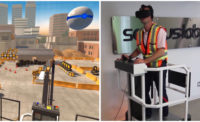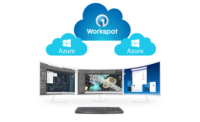Trying to keep projects moving during a viral pandemic and partial construction freeze is no small task, and project teams are finding new ways to keep things on schedule when site visits and office meetings are no longer viable. BIM-enabled virtual-reality setups haves been around for years, but tools once seen as marketing gimmicks and expensive toys have since matured into usable mediums for design and review.
“These days it’s hard to get everyone into one room—we’re limited to small groups standing 6 feet apart,” says Andy Leek, vice president of technology and innovation at St. Louis-based general contractor Paric Corp. “But working in VR, if someone brings up a design issue we can load up a model and get in there.”
For ENR’s latest coverage of the impacts of the COVID-19 pandemic, click here
InsiteVR is one tech firm offering virtual reality BIM review, and it’s fully integrated into Autodesk’s BIM360 cloud-based platform. BIM models can be loaded up in VR with a few clicks. Annotations and notes made in VR are automatically captured in the BIM, and can be used to automatically generate RFIs and other project documents.
Paric has been using InsiteVR for all phases of projects, from early design work through construction and final handoffs. “Recently, because of the [COVID-19] stuff, we have had a number of real estate and sales people call to see if we could load up their models so someone could walk through a rentable space,” says Matthew Wellhausen, VDC manager at Paric. “So, every stage of the project we’ve touched or used VR.”
The current pandemic is driving some in the industry to seek out VR for remote viewing and collaboration, according to Angel Say, co-founder of InsiteVR. “We’re definitely seeing more interest from those who have already tried out VR now that they see it can be done from home,” he says. InsiteVR has been around for six years, but Say notes that construction firms with a more mature BIM infrastructure are getting more out of VR than before. “Companies with BIM and a single-source-of-truth approach are our ideal customers right now,” Say says. “For every hour or dollar you put into VR, we want to make sure you maximize the value—we only want to amplify the workflows that people already have.”
Working with VR has also been aided by the introduction of more affordable hardware such as the $300 Oculus Quest headset. Unlike similar high-powered VR headsets, the Quest has no wires coming from the headset or controllers and is a stand-alone unit that doesn’t need to be tethered to a powerful PC. “A couple of years ago a setup like that would have cost you a couple thousand bucks,” says Leek. “Now you can get in much cheaper, and it’s not a hassle to set up.”
In a demo with InsiteVR and Paric employees, ENR was able to navigate a BIM file of a laboratory project using the Oculus Quest headset. Individual elements of the model can be highlighted and viewed with their BIM data visible. Speech-to-text annotations were available for dictating questions or comments on the model elements, and the model can be viewed at human scale or from above.
But the real value was in collaborating with a half-dozen other users in the space, clearly seeing what details in the model one person was discussing or marking up. The ability to quickly spot design clashes or understand issues around traffic flow and equipment installation could save a lot of angry emails and phone calls.
“One RFI can typically take four or eight hours to resolve, but with this you can really dial it in,” says Leek. “I think VR pays for itself in the first meeting.”






